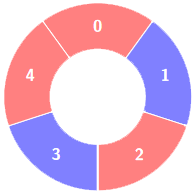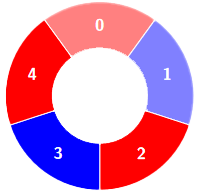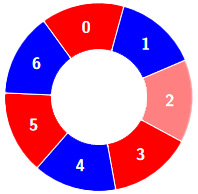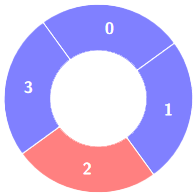Alternating Groups 2
Problem
There is a circle of red and blue tiles. You are given an array of integers colors and an integer k. The color of tile i is represented by colors[i]:
colors[i] == 0means that tileiis red.colors[i] == 1means that tileiis blue.
An alternating group is every k contiguous tiles in the circle with alternating colors (each tile in the group except the first and last one has a different color from its left and right tiles).
Return the number of alternating groups.
Note that since colors represents a circle, the first and the last tiles are considered to be next to each other.
Examples
Example 1:
Input: colors = [0,1,0,1,0], k = 3
Output: 3
Explanation:

Alternating groups:



Example 2:
Input: colors = [0,1,0,0,1,0,1], k = 6
Output: 2
Explanation:

Alternating groups:


Example 3:
Input: colors = [1,1,0,1], k = 4
Output: 0
Explanation:

Constraints
3 <= colors.length <= 1050 <= colors[i] <= 13 <= k <= colors.length
Solution
First:
- Colours are represented using integers:
0for red,1for blue. kis the size of the group to check.- The array
colorsrepresents a circular arrangement of tiles, meaning the last and first elements are adjacent in the circle.
Method 1 - Sliding Window
Here are group properties:
- A group of size
kis alternating if: - Each tile alternates in colour with its neighbours. - For a valid group:
- If the first tile is 0 (red), the expected sequence alternates as
0, 1, 0, 1.... - If the first tile is 1 (blue), the expected sequence alternates as
1, 0, 1, 0....
- If the first tile is 0 (red), the expected sequence alternates as
Because input is circular, extend the colours array by concatenating a copy of itself. This way, we can perform straightforward index-based checks across the potentially end-overlapping groups.
Algorithms
- Extend the array by concatenating
colorswith itself. - Check all possible windows of size
kin the extended array. - Compare each potential group with a valid alternating pattern.
- Count the number of valid groups.
Code
Java
class Solution {
public int countAlternatingGroups(int[] colors, int k) {
int n = colors.length;
int[] extColors = new int[2 * n];
// Extend the array to handle circularity
System.arraycopy(colors, 0, extColors, 0, n);
System.arraycopy(colors, 0, extColors, n, n);
int ans = 0;
// Check all possible starting points in the original array
for (int i = 0; i < n; i++) {
if (isAlternating(extColors, i, k)) {
ans++;
}
}
return ans;
}
// Helper method to check if a group is alternating
private boolean isAlternating(int[] extColors, int start, int k) {
int expected = extColors[start];
for (int i = 1; i < k; i++) {
expected = 1 - expected; // Flip between 0 and 1
if (extColors[start + i] != expected) {
return false;
}
}
return true;
}
}
Python
class Solution:
def countAlternatingGroups(self, colors: List[int], k: int) -> int:
n: int = len(colors)
ext_colors: List[int] = colors + colors # Extend array to handle circularity
ans: int = 0
def is_alternating(start: int) -> bool:
expected: int = ext_colors[start]
for i in range(1, k):
expected = 1 - expected # Flip between 0 and 1
if ext_colors[start + i] != expected:
return False
return True
# Check all possible starting points in the original array
for i in range(n): # Only 'n' checks are required due to circularity
if is_alternating(i):
ans += 1
return ans
Complexity
- ⏰ Time complexity:
O(k * n), wherekis sliding window size andnis size of the input array. - 🧺 Space complexity:
O(n)as the extended array requiresO(n)additional memory.